Geology Reference
In-Depth Information
1.0
1.0
B
C
A
800
Growth
Death
0.8
0.8
600
P. p
0.6
0.6
400
0.4
0.4
P. p
200
0.2
0.2
Colonization
R.g
R.g
0
0
0
0
10,000
20,000
0
100
200
300
0
1
2
3
4
Population Size (#)
Lichen Diameter (mm)
Lichen Age (yr)
The Biology Behind Lichenometry
80
300
D
E
R. geographicum
maximum size
P. pubsecens
maximum size
60
200
10
4
10
4
40
10
3
10
3
10
2
10
2
100
20
0
0
0
100
200
300
0
100
200
300
Surface Age (yr)
Surface Age (yr)
Fig. 3.7
The biology behind lichenometry.
A-C. Rates of colonization, growth, and cumulative survival estimated for
Rhizocarpon geographicum
(dashed lines)
and
Phyllostachys pubescens
(solid lines) populations at Iceberg Lake, Alaska. The growth rates of both species B are
lowest in the smallest lichens, as biologists predict. D, E. Results for
R. geographicum
and
P. pubescens
from many
simulations of an evolving lichen population that predicts the maximum lichen diameter to be measured by randomly
sampling the population on surfaces of increasing age. Dashed black line shows the largest possible thallus in an
infinitely large sample. Mortality ensures that large lichens are extremely rare on old surfaces, so in practice the
largest lichen increasingly falls off from this theoretical maximum as sample size decreases, giving rise to the “great
growth” pattern displayed in most lichenometric dating curves. Modified after Loso and Doak (2005).
the growth rate. Protection from the sun and
wind does promote more rapid growth, such
that Bull (1996), for instance, measured only
exposed lichens. Harking back to the biological
model, this dependence translates into spatial
variation in colonization rates, growth rates, and
probabilities of death that are likely functions of
exposure of the site to one or another environ-
mental variable. Whereas further testing of the
population techniques for lichenometry is war-
ranted, this approach holds remarkable promise
for developing rather detailed chronologies on
geomorphic surfaces less than 500 years old.
This age range is of great interest to paleoseis-
mology, but one in which absolute age control is
often difficult to achieve.
Absolute dating methods
Most absolute dating methods rely on some
process that occurs at a regular rate - in essence,
a clock. In some instances, these clocks leave a
physical record that may be biological, as typified
by tree rings, or geological, as represented by
annual lake beds or varves. The remaining
techniques rely on either atomic clocks or cosmic
clocks or both. Here we review the fundamental
concepts of the atomic clocks we will use.
Some (parent) atoms spontaneously decay
through fission to other (daughter) atoms plus
associated nuclear fragments plus energy. These
events are called radioactive decays. Whereas
any particular parent atom may decay at any













































